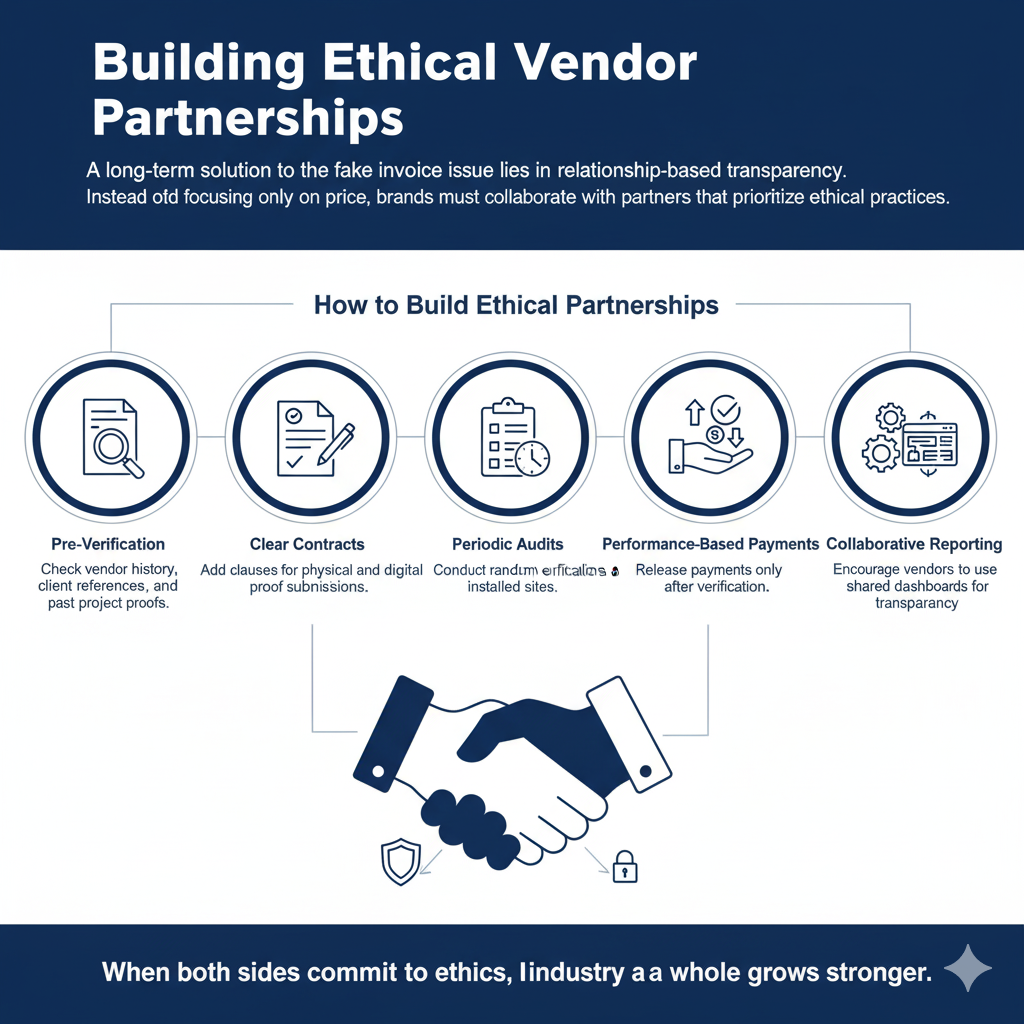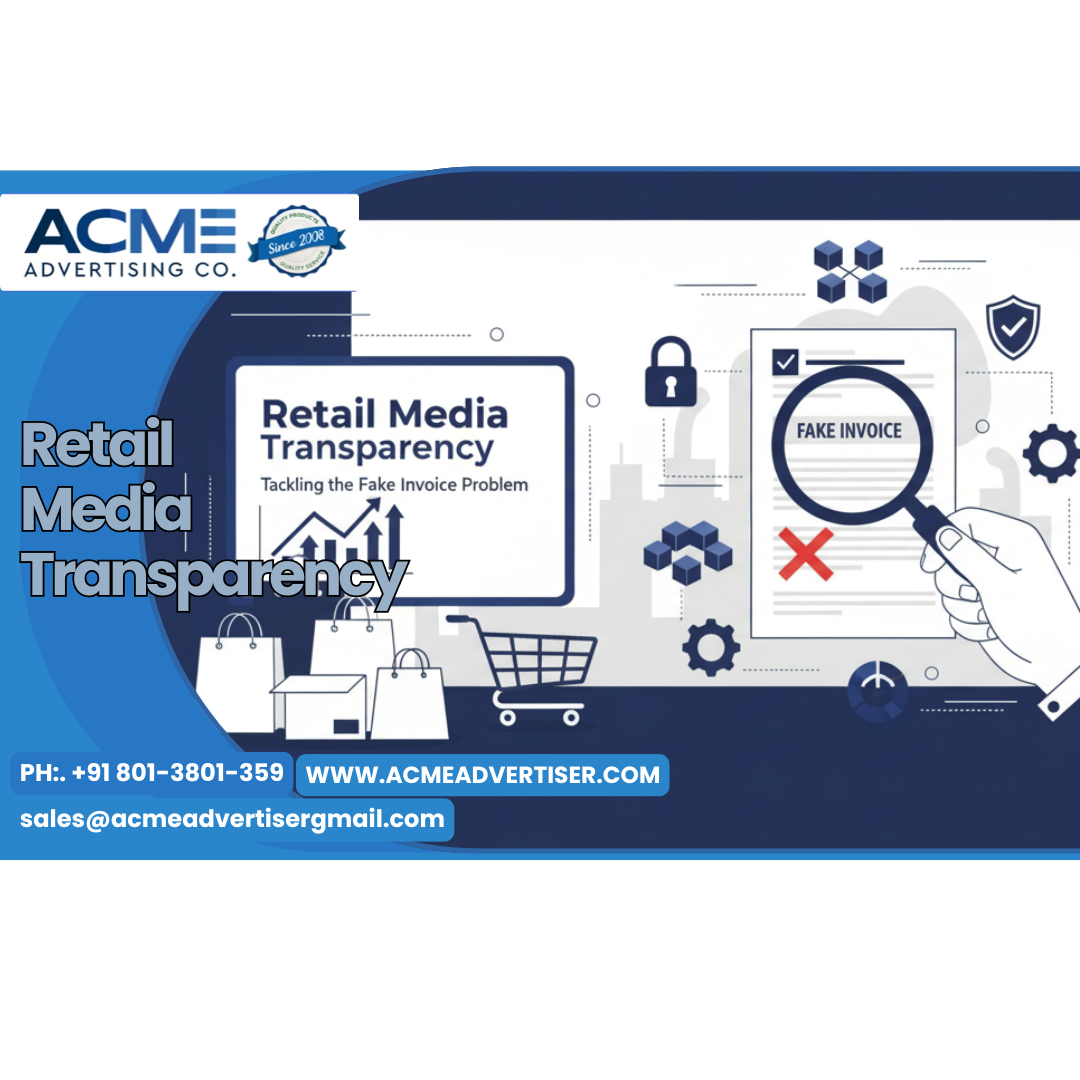
- Introduction: The Growing Power of Retail Media
- The Hidden Challenge — Fake Invoices in Retail Advertising
- How Fake Billing Works in Display and Signage Campaigns
- Real-World Impact on Brands and Retailers
- Why Transparency is the Foundation of Trust in Retail Media
- The Role of Technology in Preventing Fraudulent Invoicing
- Key Indicators That Help Identify Fake Invoices
- Building Ethical Vendor Partnerships
- Benefits of Verified Retail Media Practices
- How Companies Like Acme Advertising Co. Ensure 100% Transparency
- Industry Insights: A Shift Toward Accountability
- The Way Forward — Building a Fair, Trusted Retail Media Ecosystem
- Conclusion: The Power of Ethical Advertising
Retail Media Transparency: The Growing Power of Retail Media

Retail media has rapidly evolved from simple in-store promotions to a multi-billion-dollar advertising ecosystem. Whether it’s LED signage in supermarkets, digital screens in malls, or shelf displays at retail stores — every touchpoint influences customer decisions.
Hidden Challenge — Fake Invoices in Retail Advertising
In a perfect world, every advertising rupee should bring visible impact — a well-lit display, a branded standee, or a glowing digital screen.
However, in some cases, vendors generate invoices for work that was never executed — signage that was never installed, displays that were never printed, or campaigns that were reported as “live” without proof.
For example:
- A vendor claims that 50 store boards were installed across city outlets but delivers only 20.
- Billing documents are sent to brand managers with manipulated photos.
- Some even reuse old display images to claim new installations.
These small incidents add up — costing brands lakhs of rupees and eroding confidence in retail media operations.
How Fake Billing Works in Display and Signage Campaigns
Fake invoicing often follows a pattern. Understanding it helps prevent future losses.
a. Overbilling or Ghost Installations
The vendor bills for more locations than actually installed — e.g., charging for 100 store signage but only installing 70.
b. Photo Manipulation
Vendors sometimes send the same display photo from different angles or digitally edited visuals to “prove” installations.
c. Absence of Geo-Proof
Without GPS-tagged or time-stamped installation images, it becomes difficult to verify whether the campaign ever went live.
d. Fake Partner Chains
Some smaller subcontractors claim payments on behalf of main vendors but disappear after billing.
Real-World Impact on Brands and Retailers
The financial implications are significant, but the real damage goes deeper:
- Wasted Marketing Budgets: Brands lose funds that could have gone toward genuine reach and engagement.
- Eroded Trust: Retailers become skeptical of new vendors, slowing down future partnerships.
- Reputational Risk: False reporting damages brand credibility — especially if retailers or customers discover uninstalled ads.
- Operational Delays: Teams spend weeks verifying physical proofs instead of strategizing future campaigns.
When transparency breaks, everyone in the chain — from advertisers to shop owners — pays the price.
Why Transparency is the Foundation of Trust in Retail Media
Retail media operates in a unique space where offline meets digital accountability. Unlike online ads that generate instant metrics, offline campaigns rely on field execution. That’s why trust and verification are at the heart of successful brand-retail partnerships.
Transparent operations ensure:
- Accountable reporting with GPS-based proofs
- Clear documentation of display materials and locations
- Verified completion before billing
Brands that demand transparency not only safeguard their investment but also build long-term vendor loyalty.
The Role of Technology in Preventing Fraudulent Invoicing
Thanks to innovation, fake invoicing can now be detected early using modern tools and systems.
Here’s how technology can help:
a. GPS & Time-Stamped Proofs
Vendors can share installation photos embedded with GPS coordinates and timestamps. This acts as a digital signature that cannot be faked easily.
b. Cloud-Based Reporting
Platforms like Google Drive or CRM-integrated dashboards allow clients to view live installation updates.
c. QR Codes on Displays
Every display can have a QR code linked to its installation proof and location, ensuring easy verification.
d. Automated Audit Systems
AI-driven audit platforms can detect image duplication or inconsistencies in vendor submissions.
At Acme Advertising Co., every campaign is backed by verified image proofs, geo-tags, and real-time tracking, ensuring that brands get exactly what they pay for.
Key Indicators That Help Identify Fake Invoices
Here are simple signs that can help identify suspicious vendor activities early:
- The same image is shared multiple times for different locations.
- Invoice mentions “installation completed” without proofs.
- No GPS coordinates or timestamps are available.
- Vendor avoids site visits or proof requests.
- Discrepancies between billed quantities and retailer confirmations.
These red flags help brands take quick corrective action before the problem escalates.
Building Ethical Vendor Partnerships
A long-term solution to the fake invoice issue lies in relationship-based transparency.
Instead of focusing only on price, brands must collaborate with partners that prioritize ethical practices.
How to Build Ethical Partnerships
- Pre-Verification: Check vendor history, client references, and past project proofs.
- Clear Contracts: Add clauses for physical and digital proof submissions.
- Periodic Audits: Conduct random verifications of installed sites.
- Performance-Based Payments: Release payments only after verification.
- Collaborative Reporting: Encourage vendors to use shared dashboards for transparency.
When both sides commit to ethics, the industry as a whole grows stronger.
Benefits of Verified Retail Media Practices
Brands that follow a verified advertising process gain multiple benefits beyond financial safety.
a. Enhanced Brand Credibility
Customers and retailers trust brands that invest in visible, authentic displays.
b. Better ROI Tracking
With proof-based reporting, it’s easier to measure campaign effectiveness.
c. Cost Optimization
Eliminating fake invoices saves money that can be reinvested into real impact advertising.
d. Strengthened Vendor Relationships
Transparent collaboration fosters long-term business partnerships.
e. Improved Campaign Efficiency
Less time is wasted in verification, allowing teams to focus on creativity and performance.
How Companies Like Acme Advertising Co. Ensure 100% Transparency
Acme Advertising Co., one of India’s trusted outdoor and retail advertising partners, has built a strong reputation for authentic execution and ethical media management.
Here’s how Acme ensures reliability:
- GPS-Verified Proofs of every installed retail signage
- Live Campaign Tracking Dashboard for clients
- High-Quality Material Audits to prevent low-grade printing
- Vendor Screening Process for credibility checks
- End-to-End Service Transparency, from billing to removal
By prioritizing transparency and technology, Acme Advertising Co. not only helps brands avoid fraudulent billing but also ensures maximum visibility and real impact at every retail touchpoint.
Industry Insights: A Shift Toward Accountability
India’s retail advertising industry is gradually moving toward a proof-first approach.
Leading brands now require:
- Photo audits with time/location tags
- Digital proof reports integrated with campaign summaries
- Third-party verification audits before payment release
This shift is not just about preventing fraud — it’s about transforming how retail media is valued.
By blending trust, proof, and technology, the ecosystem is evolving into a more professional, measurable, and performance-driven landscape.
12. The Way Forward — Building a Fair, Trusted Retail Media Ecosystem
The fake invoice problem won’t disappear overnight — but industry collaboration can minimize it.
Here’s how the future of ethical retail advertising looks:
- Standardized Reporting Formats across agencies and vendors
- Training Programs for retail teams on verification methods
- Adoption of Digital Auditing Tools
- Vendor Rating Systems to reward transparency
- Client Awareness Campaigns about ethical billing
By combining honesty with accountability, the industry can move toward a new era — where every invoice equals verified visibility.
The Power of Ethical Advertising
Retail media thrives on visibility and trust. When vendors, agencies, and brands align on integrity, the results are powerful — impactful campaigns, long-term relationships, and better ROI.
The issue of fake invoices is not just about money — it’s about preserving the credibility of the advertising ecosystem.
As transparency and technology continue to reshape this space, ethical practices will become the new competitive advantage.
At Acme Advertising Co., the commitment is simple — “If it’s billed, it’s verified.”
Every signage, every board, and every display stands as a genuine reflection of a brand’s trust in us.
So the next time you plan a retail media campaign, remember:
Transparency isn’t just a policy — it’s the foundation of real brand impact.





